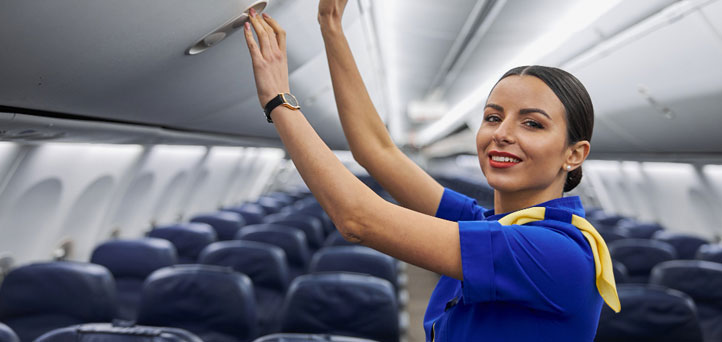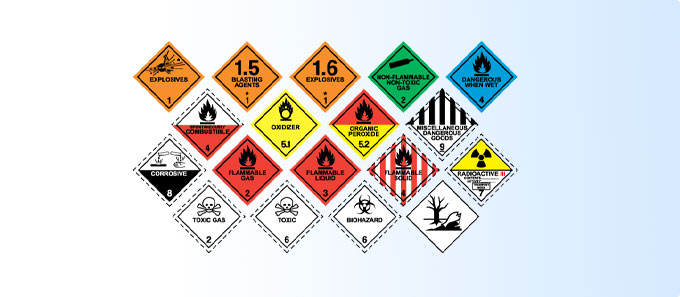Dangerous Goods or Hazardous Material (HAZMAT) are items that due to their chemical or physical qualities could endanger the safety of an aircraft or persons on board the aircraft. The transportation of such items is restricted and governed by the Civil Aviation Regulations.United Nations, International Civil Aviation Organization (ICAO) and International Atomic Energy Agency (IAEA) direct that all persons involved in the preparation, storage, carriage and handling of dangerous goods and radioactive material must have appropriate training as per their job roles in one of the 17 DG categories.The amount of training required depends on the tasks undertaken. Initial and recurrent in-depth training must be taken by shippers, packers, cargo agents, Airlines and Airport Operators including Ground-Handling Agency staff.Dangerous Goods Regulations – Certified by IATA & DGCA (Govt. of India).
Speedwings' Rigorous Process Ensures Precision, Compliance, and Safety in Dangerous Goods Training for Enhanced Workplace Competence. Speedwings has introduced a comprehensive Dangerous Goods (HAZMAT) Training program in response to ICAO's shift from category-based to competency-based training (Doc 10147). Aligned with ICAO Technical Instructions (Doc 9284) and the IATA Dangerous Goods Manual (Edition 65, 2024), this initiative is tailored to the Indian legal framework.It aims to cultivate a skilled workforce for secure air transport, emphasizing competency at all levels. The program integrates principles from ICAO Annex 18 and Annex 19, highlighting a symbiotic relationship for heightened aviation safety. Stakeholders benefit from streamlined processes and effective coordination among entities, showcasing Speedwings' commitment to industry expertise and compliance.CBTA-based Well-defined Functions:
| Well defined function | Task lists |
|---|---|
| 7.1 | Personnel Responsible for Preparing Dangerous Goods Consignments |
| 7.2 | Personnel Responsible for Processing or Accepting Goods Presented as General Cargo |
| 7.3 | Personnel Responsible for Processing Dangerous Goods Consignments |
| 7.3 | Personnel Responsible for Accepting Dangerous Goods Consignments |
| 7.4 | Personnel Responsible for Handling Cargo in a Warehouse, Loading and Unloading Unit Load Devices, and Loading and Unloading of Aircraft Cargo Compartments |
| 7.5 | Personnel Responsible for Accepting Passenger and Crew Baggage, Managing Aircraft Boarding Areas, and other Functions involving Direct Passenger Contact at an Airport |
| 7.6 | Personnel Responsible for the Planning of Aircraft Loading |
| 7.7 | Flight Crew |
| 7.8 | Flight Operations Officers and Flight Dispatchers |
| 7.9 | Cabin Crew |
| 7.10 | Personnel Responsible for the Screening of Passengers and Crew and their Baggage, Cargo, and Mail |
These specific functions are typically carried out in cargo and passenger operations, necessitating dangerous goods training. The provided task list in the Functions section serves as a basis for creating training and assessment programs.
It's important to note that the tasks, sub-tasks, and proficiency levels are recommendations. Personnel with additional responsibilities may need extra training, while those with fewer duties may require less. Employers may also organize job functions differently, resulting in varied training specifications. The employer holds the responsibility of ensuring that employees are competent in their assigned functions, requiring appropriate training programs. These dangerous goods training programs must gain approval from the national authority, adhering to relevant national regulations, policies, and procedures.
Training guidelines based on ICAO Doc 10147 and IATA DGR competency-based training and assessment guidelines under Function F1 to F10 and subject to national law.






 Function 7.1
Function 7.1
Personnel preparing dangerous goods receive tailored training focused on specific classes and tasks. Their objectives include ensuring compliance, proper classification, packaging, documentation, risk assessment, and effective communication for safe transport.
 Function 7.2
Function 7.2
(Previously covered under Category 1 & 2)
Staff tasked with processing or accepting goods labeled as general cargo must be familiar with dangerous goods regulations to identify such consignments. Training and assessment for those handling general cargo may focus on specific classes, divisions, or UN numbers eligible for transportation.
 Function 7.3
Function 7.3
(Previously covered under Category 3 & 6)
Personnel tasked with processing or accepting dangerous goods consignments must possess the necessary skills to verify and validate compliance with air transport regulations and ensure the goods' fitness for transport. These personnel may be associated with freight forwarders, ground handling agents, or operators. Adequate knowledge is essential for competent task performance, and the provided extract outlines the specific tasks and sub-task's responsibilities.
 Function 7.4
Function 7.4
(Previously covered under Category 8)
Personnel responsible for warehouse cargo handling, unit load device operations, and loading/unloading passenger baggage and aircraft cargo compartments require training and assessment for specific tasks to perform their assignments.
 Function 7.5
Function 7.5
(Previously covered under Category 9)
Personnel entrusted with responsibilities such as accepting passenger and crew baggage, managing aircraft boarding areas, and engaging in direct passenger contact at an airport need training and assessment to effectively ensure passenger safety by preventing the transportation of concealed dangerous goods in passengers' baggage.
 Function 7.6
Function 7.6
(Previously covered under Category 9)
Personnel responsible for planning aircraft loading related to dangerous goods perform critical functions such as assessing and coordinating the placement of hazardous materials within the aircraft, ensuring compliance with relevant regulations, and implementing safety measures to prevent potential risks during loading and unloading operations.
 Function 7.7
Function 7.7
Flight crew handling dangerous goods ensure proper documentation, secure stowage, and communication with ground personnel. They vigilantly monitor and respond to issues during the flight, following regulations to guarantee the safety of the aircraft and occupants.
 Function 7.8
Function 7.8
Flight operations officers and dispatchers overseeing dangerous goods coordinate documentation, secure loading, and communicate crucial information. They ensure compliance with regulations, contributing to the safe transport of hazardous materials during flights.
 Function 7.9
Function 7.9
Cabin crew members responsible for handling dangerous goods play a crucial role in ensuring the safety of passengers and the aircraft. Their duties involve inspecting, documenting, and safely stowing hazardous materials on board.
 Function 7.10
Function 7.10
Personnel screen passengers, crew, and cargo for dangerous goods compliance, ensuring safe air travel by detecting and mitigating potential risks.
Shippers and persons undertaking the responsibilities of shippers, including operator’s staff acting as shippers, operator’s staff preparing dangerous goods as Company Materials (COMAT)
Packers
Staff of Freight Forwarders involved in processing dangerous goods.
Staff of Freight Forwarders involved in processing cargo or mail (other than dangerous goods)
Staff of Freight Forwarders involved in handling, storage and loading of cargo or mail.
Operators and ground handling agent’s staff accepting dangerous goods.
Operators and ground handling agent’s staff accepting cargo or mail (other than dangerous goods)
Operators and ground handling agent’s staff involved in the handling, storage and loading of cargo or mail and baggage
Passenger handling staff
Flight crew members, loadmasters, load planners and flight operations officers/flight dispatchers
Security staff who deal with the screening of passengers and crew and their baggage and cargo or mail, e.g. security screeners, their supervisors and staff implementing security procedures.
Crew members (other than flight crew members)
Operator’s and ground handling agent’s staff accepting cargo or mail (other than dangerous goods)
Operator’s and ground handling agent’s staff involved in the handling, storage and loading of cargo or mail and baggage.
Passenger Handling Staff
Flight Crew members, Loadmasters, load planners and flight operations officers/flight dispatchers
Crew members (other than flight crew members)
Staff of designated postal operators involved in accepting mail containing dangerous goods
Staff of designated postal operators involved in processing mail (other than dangerous goods)
Staff of designated postal operators involved in the handling, storage and loading of mail


ICAO recently approved changes to several Annexes of the Chicago Convention, introduced harmonized requirements for the implementation and operation of safety management systems (SMS) by aircraft operators and aviation service providers, and linked hazard identification (dangerous goods) through competency-based approach (CBTA) to support SMS.
The concept of a proactive approach to safety is based on following a risk management strategy that includes identifying hazards before they materialize into incidents or accidents and taking the necessary actions to reduce the safety risks.
Accordingly, ICAO has changed the landscape of hazardous goods learning. It has shifted the traditional category and title-based learning to a competency-based approach (ICAO Doc 10147 and PANS-TRG.Doc-9868) on functions and responsibilities for all personnel involved in air transportation, effective from January 1, 2023.
The CBTA approach concentrates on job functions and responsibilities assigned to a person’s actual tasks concerning air transportation, to which he must be competent to perform his designated functions. It refers to a learning model where the person must demonstrate the required knowledge and skill (competency) on his assigned tasks in training and on-the-job performance at the workplace.
Integrating the ICAO guidelines on the CBTA approach, IATA revised and redefined the DGtraining with more restrictive and stringent regulations, thus making each person competently demonstrate their functional responsibilities (tasks and sub-tasks) assigned at their workplace, subject to continuous assessment by the employer.
The transition to CBTA Provider is the technology change to provide competency-based training programs based on the tasks and sub-tasks that enable the trainees to be competent to perform their job roles.
Required competencies, knowledge, skills, and attitude are determined by identifying those skills that must be present for success in the job functions.
The final competency standard is associated with job functions.
The person performing the job functions needs to demonstrate the competencies.
They must prove that the attained competencies are relevant to their job functions and can add value to their organization.
Accordingly, from 1 January 2023, all employers of personnel involved in air transportation must identify and prevent the carriage of hazardous materials in passenger checked-in or carry-on baggage and competently perform functions to ensure that dangerous goods are transported in accordance with the ICAO Technical Instructions (TI).
CBTA is essentially a framework for training people involved in transporting dangerous goods by air. IATA has revised and updated the provisions for dangerous goods training in its Dangerous Goods Regulations (DGR) manual to make the transition from conventional subject-matter-based training to skills-based and competency-based training. The employer is responsible for ensuring that personnel is competent to perform any function for which they are responsible prior to performing any of these functions. CBTA approach involves technical and professional training involving emergency responses, case studies, and group discussions. The depth of training for each person should be appropriate to the tasks performed and must be specified. It could range from a familiarization level to an expert level for specific personnel.
Title-based / category-based DG training shifted to a CBTA approach based on job Functions (Tasks and sub-tasks)
All previously used twelve categories are removed from 1st January 2023. The CBTA has replaced them with ten Functions (activity). Some tasks are subdivided into sub-tasks. This focus on the individual job responsibilities (activities) that employees actually perform, not their job role or functional titles.
An activity analysis is conducted before all DGR training courses. It looks at the individual activities involvedand knowledge in handling dangerous goods and thus provides documented insights into participants’individual training requirements for IATA DGR.Based on that, theinstructor, Designer, and Assessor must redefine the training material's relevance and the educational depth required for CBTA.
The assessment findings create a custom DGR training plan that meets CBTA criteria. Based on these findings, the instructor will plan on what skills and knowledge will be covered, the depth of the course material, and the chosen training methodology.
CBTA intensified the responsibilities of the employers to ensure that the personnel involved in air transportation must be trained and assessed commensurate with the functions they are responsible for and competently demonstrate assignments, including emergency responses.
The person involved in a specific job function must acquire the necessary knowledge and competently demonstrate skills to perform their respective functions - to prevent hidden dangerous goods, recognize the hazards presented by dangerous goods, safely handle them, and apply proper emergency response procedures.
The competency evaluation and assessment are a work-based pattern on written tests, oral quizzes, involvement in class activities, group discussion, case studies,skill,and attitude in the practical performance exercises.
The employer must provide additional training if competency is not demonstrated in the training assessment or at the workplace.
Any irregularities in the job continuity or personnel trained but assigned to a new process or responsibilities must be assessed to determine their competencies. If the person is not competent, must provide him with additional training.
The new IATA CBTA DGR credentials are issued in Montreal with the candidate’s date of birth in printable secured digital award (SDA) Certificates, secured by blockchain technology with a QR code, which guarantees the integrity of your certificate for life!
The CBTA certification is a testimony to validate that the person has acquired specific skills, attitudes, and knowledge to perform his assigned responsibilities as per the regulatory requirements competently.
The CBTA has not changed the refresher training interval of 24 months. Category-based certificates valid beyond 1st January 2023 shall be renewed per the norms of CBTA and assigned to the respective job functions.
However, follow-up training obligations or interim assessments (due to absences, etc.) may become necessary during the interval period.
Do you have any questions about converting dangerous goods training courses to the new CBTA system? Are you looking for an efficient solution?